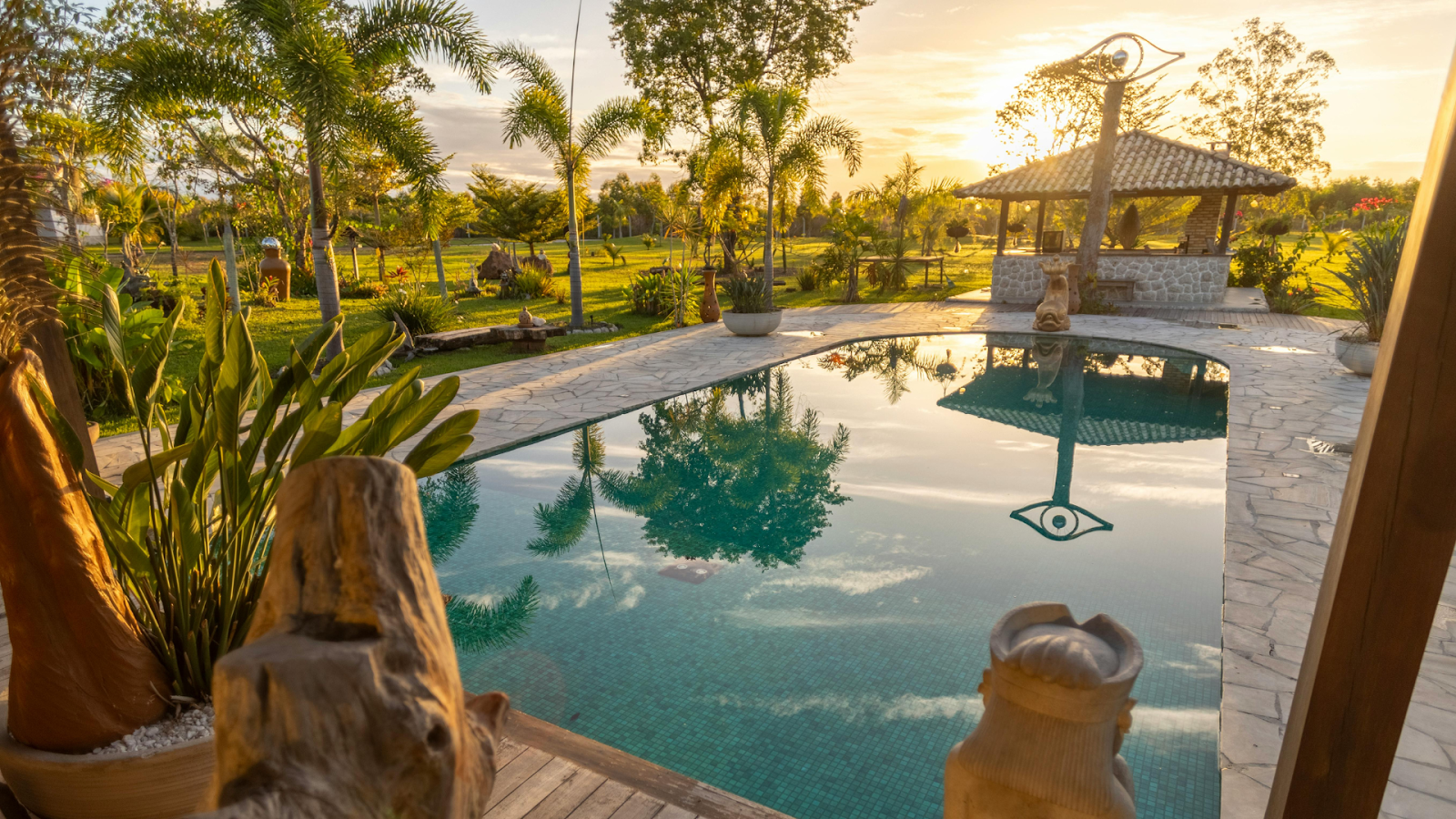To simplify the process, platforms like Teamland help businesses discover and book tailored retreat experiences that align with their unique goals, ensuring a seamless and productive getaway.
5 Second Summary
- Understand the importance of choosing the right venue
- Identify key factors to consider when selecting corporate retreat venues
- Explore the best corporate retreat locations for different team needs
Why Corporate Retreat Venues Matter

Corporate retreats are not just vacations, they are designed to improve productivity, align teams, and promote stronger workplace relationships.
The right corporate retreat locations set the stage for employees to reconnect, develop new ideas, and return to work feeling recharged and motivated.
A well-chosen retreat venue:
- Encourages Collaboration: Teams bond more effectively when placed in environments that promote open communication and teamwork.
- Reduces Workplace Stress: Changing the scenery helps employees decompress, refresh, and refocus.
- Enhances Creativity & Innovation: Unique team retreat locations encourage fresh ideas and new perspectives.
- Improves Team Bonding: Shared experiences outside of the workplace strengthen relationships and trust.
- Boosts Employee Engagement: Investing in a high-quality corporate retreat venue shows employees they are valued.
Key Factors in Choosing a Corporate Retreat Venue
Not all corporate retreat venues are the same. To find the perfect company retreat location, consider these factors:
1. Accessibility & Travel Logistics
A retreat should be easily accessible yet feel like an escape.
Consider:
- Travel time – Is the venue a short drive or a flight away?
- Transportation options – Are there direct flights or easy road access?
- Proximity to an airport – Will employees need additional transport after arrival?
2. Accommodations & Comfort
Comfort is a priority. The venue should provide:
- Comfortable lodging – Hotels, cabins, or resorts with high-quality amenities.
- On-site or nearby restaurants – Healthy and diverse food options.
- Wi-Fi & technology support – Essential for business meetings and virtual attendees.
3. Team-Building Activities
The best corporate retreat locations offer activities that foster teamwork and engagement. Look for:
- Outdoor adventure: Hiking, kayaking, ziplining.
- Wellness programs: Yoga, meditation, spa treatments.
- Business-focused sessions: Workshops, leadership training.
4. Privacy & Exclusivity
A retreat should provide an environment free from distractions. Exclusive-use resorts, private lodges, or boutique hotels often provide the best settings for focused sessions and bonding activities.
5. Budget & Value
Luxury is great, but cost-effectiveness matters too. Consider:
- All-inclusive packages with lodging, meals, and activities.
- Off-season discounts to secure premium locations at lower rates.
- Negotiating group rates for better deals.
Best Corporate Retreat Locations Based on Team Needs
Different teams have different retreat goals, so the best corporate retreat venues should align with those objectives.
1. Mountain Retreats: Best for Deep Focus & Team Bonding

Mountain retreats provide peace, fresh air, and seclusion, making them ideal for strategic planning and deep discussions.
Top Mountain Corporate Retreat Locations
Best for: Leadership retreats, deep focus sessions, and small group workshops.
- Aspen, Colorado – High-end resorts with private meeting spaces.
- Banff, Canada – Breathtaking scenery with outdoor adventure options.
- Blue Ridge Mountains, Georgia – Affordable lodges with strong team-building activities.
- Zermatt, Switzerland – Ultra-private alpine lodges with panoramic views of the Matterhorn.
- Tyrol, Austria – Cozy mountain chalets with sauna access and hiking trails for post-meeting mental resets.
- Chamonix, France – High-altitude resorts with access to skiing, mountaineering, and spacious conference cabins.
2. Beachfront Retreats: Best for Relaxation & Creative Thinking

Beach locations help teams de-stress and encourage informal networking, making them ideal for creative teams and brainstorming sessions.
Top Beach Corporate Retreat Locations
Best for: Creative professionals, marketing teams, and informal networking events.
- Malibu, California – Oceanfront villas with luxury accommodations.
- Tulum, Mexico – Wellness-focused Zen Yoga retreats from vinyasa flow to restorative, prenatal, and postnatal yoga.
- Maui, Hawaii – A mix of relaxation and adventure opportunities.
- Ibiza, Spain – Secluded villas, ocean views, and wellness perks. Perfect for big ideas.
- Crete, Greece – Classic island vibes with beach resorts and historic charm.
- Algarve, Portugal – Coastal retreats with cliffs, sun, and surf. Relaxation meets brainstorming.
3. Ranch & Desert Retreats: Best for Adventure & Leadership Training
Best for: Leadership teams, team-building exercises, and problem-solving challenges.
Ranch and desert retreats offer an immersive team-building experience with outdoor activities like horseback riding, hiking, and group challenges.
Top Ranch & Desert Corporate Retreat Locations
- Sedona, Arizona – Unique red rock landscapes with a mix of adventure and relaxation.
- Jackson Hole, Wyoming – Ranch-style resorts with leadership workshops.
- Palm Springs, California – Exclusive desert retreats with high-end amenities.
- Andalusia, Spain – Olive groves and hacienda stays. Horseback riding and rustic bonding.
- Maremma, Italy – Tuscan hills, vineyards, and country estates. Quiet, open, and rugged.
- Camargue, France – Wild wetlands, horses, and cowboy culture. Unusual and unforgettable.
4. City Retreats: Best for High-Energy & Networking Teams
Best for: Sales teams, corporate networking, and executive leadership groups.
Urban retreats offer a balance of productivity, entertainment, and cultural immersion, making them great for networking and executive retreats.
Top City Corporate Retreat Locations
- New York City, NY – World-class venues with excellent networking opportunities.
- Chicago, IL – Riverfront business hubs with cultural experiences.
- Austin, TX – Creative and tech-friendly atmosphere for innovation-driven teams.
- London, UK – Top venues, fast pace, and endless networking. Corporate meets culture.
- Berlin, Germany – Startup spirit with historic edge. Creative, bold, and edgy.
- Amsterdam, Netherlands – Compact, scenic, and smart. Great mix of business and charm.
5. Wellness & Spa Retreats: Best for Employee Well-Being & Stress Reduction

Best for: Employee appreciation retreats, mental wellness programs, and relaxation-focused corporate events.
Wellness retreats focus on mental and physical health, allowing employees to recharge and return to work refreshed.
Top Wellness Corporate Retreat Locations
- Napa Valley, California – Wine country retreats with spa treatments.
- Bali, Indonesia – Tropical resorts with yoga and meditation programs.
- Swiss Alps, Switzerland – Luxury lodges with breathtaking landscapes and wellness treatments.
- Budapest, Hungary – Famous thermal spas and riverside wellness hotels.
- Lake Bled, Slovenia – Peaceful lakeside views and boutique retreats.
- South Tyrol, Italy – Forest lodges, spa resorts, and clean mountain air.
How to Customize Your Corporate Retreat Experience
Not all retreats serve the same purpose. Some are designed for strategic planning, while others focus on team bonding, innovation, or relaxation. The best corporate retreat venues cater to these unique needs, offering amenities and environments that enhance the retreat experience.
1. Strategic Planning Retreats
If the goal is to align leadership, develop long-term business strategies, and enhance executive decision-making, a retreat should offer:
- Secluded meeting spaces for focused discussions
- Minimal distractions to keep teams engaged
- Comfortable accommodations that promote deep thinking
- Structured leadership workshops for team alignment
Best corporate retreat locations for strategic planning:
- Luxury mountain resorts in Banff, Canada
- Private estate retreats in Napa Valley, California
- Secluded island villas in the Florida Keys
2. Adventure & Team Bonding Retreats
For companies looking to break silos, strengthen trust, and improve collaboration, adventure-based retreats offer team-building exercises that challenge employees to work together.
Look for:
- Outdoor activities like whitewater rafting, ziplining, and rock climbing
- On-site adventure guides for structured team challenges
- Rustic yet comfortable lodges that encourage bonding
Best team retreat locations for adventure:
- Colorado wilderness lodges with guided outdoor excursions
- Costa Rica eco-retreats with jungle adventure courses
- Alaska survival retreats for extreme team-building experiences
3. Innovation & Creativity Retreats
If the goal is to generate fresh ideas, enhance collaboration, and inspire creative thinking, the venue should be stimulating and immersive.
Consider locations with:
- Flexible workspaces for brainstorming sessions
- Cultural immersion experiences to expand perspectives
- Scenic settings that encourage innovation and problem-solving
Best company retreat locations for innovation:
- Bali creative retreats with nature-inspired workspaces
- Lisbon startup hubs for tech and creative teams
- New Orleans boutique hotels with an artistic and cultural atmosphere
4. Relaxation & Wellness Retreats
For companies focusing on stress relief, mindfulness, and work-life balance, wellness retreats provide a tranquil escape from workplace pressures.
Look for:
- On-site spa and wellness programs
- Quiet environments with natural landscapes
- Personalized wellness activities like Mindfulness Meditation and Yoga by Teamland
Best corporate retreat locations for wellness:
- Sedona, Arizona – Healing desert retreats with spa treatments
- Hawaii beachfront resorts with guided relaxation programs
- Swiss Alps retreats with luxury wellness treatments
Hidden Gem Corporate Retreat Venues
While popular corporate retreat locations like New York, Los Angeles, and Aspen are great choices, there are lesser-known venues that provide exceptional experiences at a fraction of the cost.
1. Finger Lakes, New York
A hidden gem for leadership retreats and wellness getaways, Finger Lakes offers:
- Affordable vineyard resorts with scenic lake views
- Team-building activities like Sommelier wine tastings and boat excursions
- Quiet retreat settings away from major city distractions
2. Asheville, North Carolina
Nestled in the Blue Ridge Mountains, Asheville is ideal for teams looking for a mix of outdoor adventure and creative inspiration.
Highlights include:
- Boutique hotels and cabin resorts
- Team-building activities like hiking, whitewater rafting, and brewery tours
- A thriving arts scene that encourages innovative thinking
3. Lake Tahoe, California/Nevada
For teams looking to balance work and play, Lake Tahoe offers:
- Skiing and snowboarding in winter
- Lakefront activities in summer
- Luxury resorts with private conference rooms
4. Cartagena, Colombia
For companies looking for an international retreat destination, Cartagena provides:
- Affordable beachfront resorts
- Historic venues with colonial charm
- Unique team-building opportunities like cultural tours and sailing excursions
5. Quebec City, Canada
For a European-style retreat without the transatlantic flight, Quebec City offers:
- Château-style resorts with premium meeting spaces
- Cobblestone streets and historic sites for unique team experiences
- Great dining and cultural attractions to enhance networking
Expert Tips for Planning a Seamless Corporate Retreat
Planning a corporate retreat involves more than just choosing a venue. A well-executed retreat ensures that employees leave feeling motivated, connected, and aligned with company goals. To create a successful experience, companies must consider factors such as scheduling, accommodations, activities, and engagement strategies.
1. Start Planning Early
The best corporate retreat venues book up quickly, especially in peak travel seasons. Without early planning, companies risk limited availability, higher costs, and logistical challenges.
Booking a venue six to twelve months in advance secures the best locations, ensures lower rates, and provides time to coordinate travel, lodging, and team-building activities. Choosing off-season dates can also result in significant cost savings while offering a more exclusive experience.
2. Define Clear Objectives
A corporate retreat should have a well-defined purpose to ensure it remains productive and beneficial to employees. Retreats can focus on leadership development, team bonding, strategic planning, or employee wellness.
The venue should align with the retreat's goals to create the best possible experience. If the objective is strategic planning, a venue with private meeting rooms, strong Wi-Fi, and business-friendly amenities is essential.
3. Balance Work and Play
A retreat should blend structured work sessions with opportunities for relaxation and social interaction. Overloading the schedule with meetings and presentations can make the retreat feel like another work obligation, while too much downtime may make it feel unproductive.
Incorporating half-day work sessions and dedicating afternoons to team-building activities creates a balanced experience. Employees should have opportunities for informal networking, outdoor activities, and personal relaxation.
4. Prioritize Comfort and Convenience
The retreat experience should be comfortable and stress-free. Employees are more engaged when they have access to high-quality accommodations, convenient travel options, and diverse dining choices.
The ideal venue should offer comfortable lodging with modern amenities, high-speed internet, and private meeting spaces. Food is another important factor, as dietary restrictions should be considered to ensure every employee is accommodated.
5. Plan Engaging Team-Building Activities
Team-building activities should go beyond simple icebreakers and create meaningful opportunities for collaboration and connection. Outdoor adventures such as ziplining, whitewater rafting, or rock climbing encourage trust and teamwork.
Escape rooms or scavenger hunts challenge employees to problem-solve together. Cooking classes, mixology workshops, or volunteer projects add a unique and interactive element to the retreat.
6. Allow for Flexibility and Individual Needs
Not every employee enjoys the same type of retreat experience, and forcing participation in certain activities can lead to discomfort or disengagement. Offering flexibility in the schedule allows employees to choose how they spend their time while still being part of the overall retreat experience.
Providing alternative activity options ensures that everyone feels included. Personal relaxation time is important, as some employees may need a break from structured interactions.
7. Set a Realistic Budget
A great corporate retreat location does not have to be expensive. With careful planning, companies can balance cost and quality to create a high-value retreat experience. Comparing multiple venues and exploring all-inclusive packages can help lower costs.
Many high-end venues offer corporate rates for large groups, and off-peak pricing can make premium locations more affordable.
Gather Feedback for Future Retreats
Post-retreat feedback is essential to improve future experiences and ensure that employees feel heard. After the retreat, companies should collect employee input through surveys or debrief sessions.
Employees should have the opportunity to share what they enjoyed, what could be improved, and what they would like to see in future retreats. Questions should focus on venue quality, preferred activities, and overall experience.
Assign a Dedicated Retreat Coordinator
A retreat involves multiple moving parts, from travel logistics and lodging to team-building activities and catering. Assigning a dedicated retreat coordinator or hiring a professional event planner ensures that everything runs smoothly.
A coordinator handles reservations, travel arrangements, and scheduling while also managing unexpected challenges. Having a point person responsible for logistics prevents last-minute chaos and allows employees to focus on enjoying the retreat.
Create an Agenda That Flows Well
An effective retreat agenda should be structured but flexible, allowing employees to engage in meaningful work sessions while also having time to relax and socialize. A well-balanced schedule includes a mix of strategy discussions, team-building activities, and free time for employees to recharge.
A sample corporate retreat schedule might include an arrival day with informal networking and icebreaker activities, followed by a second day of strategy workshops, breakout sessions, and outdoor adventures.
Final Thoughts
A corporate retreat is an investment in team growth, morale, and productivity. The success of your retreat depends on choosing the right corporate retreat venues that align with your team’s needs and company objectives.
From mountain lodges and beachfront escapes to high-energy city retreats, selecting the perfect company retreat location ensures that employees leave feeling motivated, connected, and aligned with company goals.
When planned thoughtfully, a retreat becomes more than just a corporate event, it becomes an experience that fosters long-lasting relationships, strategic clarity, and a renewed sense of purpose. Choose the right team retreat location, and your next corporate retreat will be a game-changer.
Platforms like Teamland simplify the retreat planning process by offering tailored experiences, venue recommendations, and engaging team-building activities. Whether you’re looking for an adventure-filled escape or a focused strategy retreat, Teamland helps curate the perfect experience to match your company’s vision.
Choose the right team retreat location, leverage expert resources like Teamland, and turn your next corporate retreat into a game-changing experience that drives real results.
FAQs
What is the best month for retreats?
The best month for a corporate retreat depends on the company’s objectives, location preferences, and budget. Spring and fall are the most popular choices as they offer mild weather, fewer travel disruptions, and lower off-season rates compared to summer and the holiday months. Fall is particularly effective for strategic planning as it coincides with year-end goal setting, while spring is ideal for team-building and rejuvenation after the winter months.
How long does a retreat last?
The duration of a corporate retreat varies based on its purpose and scope. Most retreats last between two to four days, balancing structured activities with free time for networking and relaxation. A single-day retreat works well for intensive workshops or leadership meetings, while multi-day retreats allow for a more immersive experience that includes team bonding, strategic discussions, and personal development.
How do you create a budget for a retreat?
Creating a budget for a retreat starts with defining clear objectives and estimating the number of attendees. Major costs include travel, accommodations, meals, activities, venue rental, and any professional facilitators or speakers. Setting a per-person budget helps manage expenses, while early booking and off-season scheduling can reduce costs. Comparing multiple venue options, negotiating group discounts, and considering all-inclusive packages simplify cost management.
How to facilitate a corporate retreat?
Facilitating a corporate retreat requires a well-planned agenda that keeps participants engaged while achieving the retreat’s objectives. The retreat should start with an introduction that establishes expectations and goals, followed by a structured mix of strategic discussions, collaborative exercises, and team-building activities. A facilitator, whether an internal leader or an external consultant, should guide conversations, ensure balanced participation, and keep the retreat on track. Flexibility is key to adapting the agenda based on team dynamics and energy levels.







